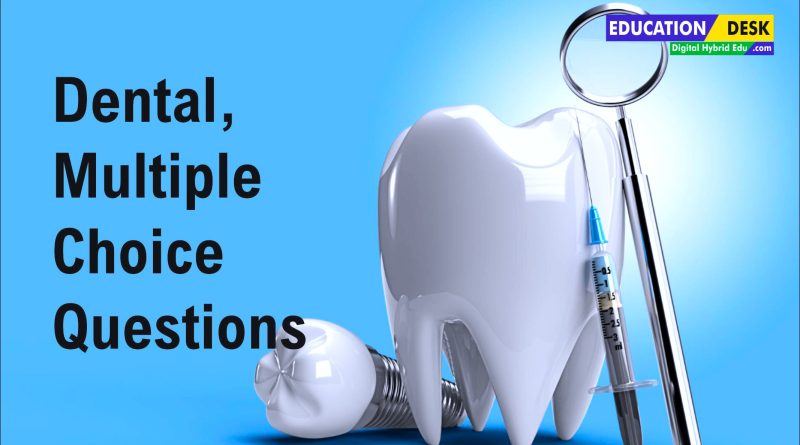200 +Dental MCQs for MBBS Students 2024-25
“200 +Dental MCQs for MBBS Students 2024-25”
5th Test (MCQs)
MBBS Students, You can seen here for your became a future Examination, Multiple Choice Questions with answer and and Learned about.
Characteristic signs for a cancerous ulcer on the lower lip and the oral mucosa are
- moderate pain, the edges are swollen, brightly hyperemic, at the bottom – purulent-fibrinous plaque
- moderate soreness, inverted, raised edges, necrotic tissue at the bottom
- sharp soreness, thinned edges, glassy granulations on the bottom
- the absence of pain, grease the bottom with a yellowish scale
Organ-specific tumors of the maxillofacial region include: (select several correct answers)
- epulis
- osteoblastoclastoma
- ameloblastoma
- hemangioma
- osteoma
Organ-specific tumors of the maxillofacial region include: (select several correct answers)
- ostema
- epulis
- angioma
- osteoblastoclastoma
- ameloblastoma
The main method of treatment for common cancer of the lower lip and oral mucosa is
- radiation therapy
- surgical
- chemotherapy
- combined method
- electrocoagulation of the tumor
The main method of treatment of fibromas and papillomas of the oral and maxillofacial region is
- radiation therapy
- excision on the boarder of tumor and healthy tissues
- chemotherapy
- cauterization
Early symptoms of malignant tumors of the jaws are
- tooth mobility, intermittent aching pain symptom Vincent, thickening of the jaw
- dry mouth, paroxysmal acute pain, difficulty swallowing
- hypersalivation, chills, both-sides infiltration of the jaw
The clinical picture of fibrous epulis is characterized by
- dense, painful infiltration in the area of several teeth
- 2-3 erosions of gums, with no tendency to bleeding and epithelialization
- dense, painless formation on a wide base
- loose, painful bleeding gum formation
- local gum keratinization
Cause of radicular cyst is
- transferred osteomyelitis of the jaw
- violation of the development of the rudiment of the tooth
- jaw trauma
- complication of chronic periodontitis
In case of metastases of cancer of the maxillofacial region to regional lymph nodes, which operation is performed
- radical neck dissection
- Redon
- Vincent
- Caldwell-Luc
The clinical picture of ameloblastoma is characterized by
- painful defect of the jaw bone tissue
- painless deformity of the jaw in the form of swelling
- 2-3 erosions of gums, with no tendency to bleeding and epithelialization
- loose painful bleeding gum formation
- dense, painful infiltration in the area of several teeth
Early symptoms of malignant tumors of the jaws are
- teeth mobility, periodic pain, symptom Vincent, thickening of the jaw
- dry mouth, paroxysmal acute pain, difficulty swallowing
- hypersalivation, chills, both-sides jaw swelling
*Papilloma is characterized by
- pain
- the presence of a seal; and the mucous membrane around its base
- lack of tissue infiltration around its base
- the rapid growth
The main method of small odontogenic cysts treatment is
- cystectomy
- cryodestruction
- half resection of the jaw
- sclerosis
- partial resection of the jaw
The main etiological factors in the development of malignant tumors of the oral mucosa are: (select several correct answers)
- hypersalivation
- precancerous diseases
- massive dental deposits
- partial tooth loss
- diseases of the gastrointestinal tract
- prolonged irritation of the oral mucosa by mechanical, chemical, and temperature factors
Additional research methods used to clarify the diagnosis of “malignancy of the maxillofacial region” include: (select several correct answers)
- histological
- angiographic
- physical
- cytological
- biochemical
- immunological
Characteristic signs for a cancerous ulcer on the lower lip and the oral mucosa are
- moderate soreness, inverted, raised edges, necrotic tissue at the bottom
- the absence of pain, grease the bottom with a yellowish scales
- moderate pain, the edges are swollen, brightly hyperemic, at the bottom – purulent-fibrinous plaque
- sharp soreness, thinned edges, glassy granulations on the bottom
Osteoma on the x-ray shows up as
- an area of osteoporosis
- an area of high density with clear contours
- an area of high density without clear contours
- a reduce of bone density
The brancial cyst of the neck localized
- in the middle third of the neck, along the anterior edge of the sternocleidomastoid muscle
- along the anterior edge of the trapezoid muscle
- in the submandibular region
- in submental region
- along the midline of the neck
*The main method of treatment for lower lip and oral mucosa spread cancer is
- radiation therapy
- combined method
- chemotherapy
- electrocoagulation of the tumor
- surgical
Ameloblastoma belongs to the group of
- benign odontogenic tumors
- malignant odontogenic tumors
- inflammatory diseases
- precancerous diseases
- tumor-like formations
The stage of malignant neoplasm is established on the basis of clinical signs
- patient complaints
- the size of the tumor
- the size of the tumor, the presence of distant and nearby metastases
- complaints of the patient, the size of the tumor
- the size of the tumort the presence of nearby metastases
The clinical picture of ameloblastoma is characterized by
- painless deformation of the jaw in the form of swelling
- painful defect of the jaw bone tissue
- dense painful infiltration in the area of several teeth
- 2-3 erosions of gums, with no tendency to bleeding and epithelialization
- loose painful bleeding gum formation
Clarifying the diagnosis of a dermoid cyst helps
- x-ray
- electromyography
- cytological examination of punctate
- the study of blood
Causes of dermoid cyst
- violation of the embryonic development of the maxillofacial region
- injury
- complication of chronic periodontitis
- transferred inflammatory process in soft tissues
One of the main surgical methods for treating jaw cancer is
- electrocoagulation of the tumor
- radical neck dissection
- Caldwell-Luke
- half resection of the jaw
Fibroma characterizes by
- rapid growth
- ulceration of the mucous membrane covering it
- pain
- slow growth
Causes of follicular cysts is
- violation of the development of the rudiment of the tooth
- transferred osteomyelitis of the jaw
- trauma to the jaw
- complication of chronic periodontitis
The method of treatment of cavernous hemangioma is
- electrocoagulation
- sclerotherapy
- cauterization
- physiotherapy
- radiation therapy
The main clinical sign of cavernous hemangioma is
- the presence of erosions on the surface of the neoplasm without a tendency to bleeding
- painful infiltration
- reduction in pressure and restoration of the previous volume of the tumor after the cessation of pressure
- the presence of phleboliths
- pain during palpation of the neoplasm
The main etiological factors in the development of malignant tumors of the oral mucosa are: (select several correct answers)
- diseases of the gastrointestinal tract
- prolonged irritation of the mucous membrane by mechanical, chemical, and temperature factors
- hypersalivation
- precancerous diseases
- partial tooth loss
- massive dental deposits
Click Here for Test 1, 2, 3 & 4th
Note : All The Bold Mark is Correct option but I am not responsible for any incorrect option or answer .

